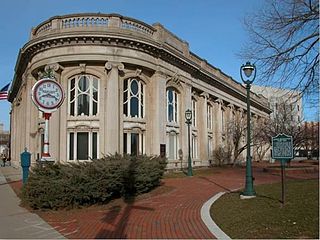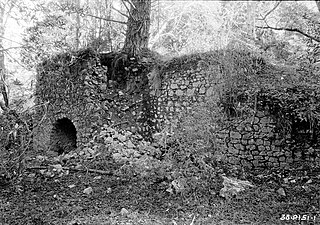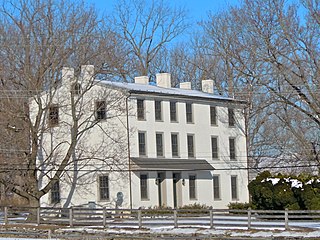History
After sitting idle for decades the Buffalo Grove Lime Kiln was acquired by the Polo Historical Society in 1985. They began clearing trees, brush and debris around the kiln. A restoration project began in 1992 at a cost of $10,000. [4] The lime kiln at Buffalo Grove has had a long history that dates back even further than the lime kiln that stands on the site today. [3]
Restoration
In 1992 a restoration project began under the guidance of the Polo Historical Society and member Paul Graehling. The old, loose mortar had to be removed from around the stones and replaced. The replacement was a fifty percent mortar fifty percent cement mix, to preserve the restoration. The wooden upper portion of the kiln had deteriorated completely beyond repair and had to be entirely replaced. [3] The top portion was constructed in sections off-site and then lifted into place using a crane. The whole structure was then topped with an aluminum roof to protect it from future deterioration. [3] The attachment of the roof rendered the kiln inoperable, although, if it were removed the Buffalo Grove Lime Kiln would be fully functional and ready for lime production. [3]
The lime house, attached to the kiln, was also fully restored. When the lime kiln was in use the small, attached room had served as a storage area but it had been gone since at least the 1930s. [3] Using early historical photographs as references, the lime house was reconstructed atop a stone foundation. The lumber used to construct the new lime house was authentic late 19th-century barn lumber. [3] Atop, the lime house, like the kiln itself, an aluminum roof was placed.
The restoration was completed in 1993 at a final cost of around $10,000. [3]

The Peak Forest Canal is a narrow locked artificial waterway in northern England. It is 14.8 miles (23.8 km) long and forms part of the connected English/Welsh inland waterway network.

Trimborn Farm is a Victorian era estate located in Greendale, Wisconsin and owned by Milwaukee County. Spanning 7.5 acres and nine buildings, it is listed on the National Register of Historic Places. The farm is also a State Historic Site and designated Milwaukee County Landmark.

The Joseph F. Glidden House is located in the United States in the DeKalb County, Illinois city of DeKalb. It was the home to the famed inventor of barbed wire Joseph Glidden. The barn, still located on the property near several commercial buildings, is said to be where Glidden perfected his improved version of barbed wire which would eventually transform him into a successful entrepreneur. The Glidden House was added to the National Register of Historic Places in 1973. The home was designed by another barbed wire patent holder in DeKalb, Jacob Haish.

The Griggsville Landing Lime Kiln is located near village of Valley City, Illinois in Pike County. The periodic lime kiln is listed on the National Register of Historic Places, a designation it gained in August 1999. It is actually within the boundaries of the Ray Norbut State Fish and Wildlife Area. The kiln represents an example of an 1850s lime kiln, one of the best-preserved examples of such a kiln. In its heyday the kiln's raw product would have been quicklime. The kiln is one of twelve Pike County sites included in the National Register of Historic Places. Some other examples are the Lyman Scott House, in Summer Hill and the New Philadelphia Town Site, somewhere near Barry, Illinois.
Adelaide Brighton Cement (ABC) is an Australian manufacturer of cement, lime and dry blended products.

The Lena Water Tower is a water tower located in the village of Lena, Illinois, United States. It was built in 1896 following two decades of problems with structure fires in the village. The current water tower is the result of a second attempt after the first structure proved to be unstable. The tower stands 122.5 feet (37.3 m) tall and is built of limestone and red brick. The current stainless steel water tank holds 50,000 gallons and replaced the original wooden tank in 1984. The site has two other structures, an old power plant building and a 100,000 US gallon reservoir. The Lena Electric Plant Building was constructed in 1905 and the reservoir completed in 1907. The Lena Water Tower was listed on the U.S. National Register of Historic Places in 1997; the reservoir was included as a contributing property to the listing.

Lime Rock (Limerock) is a village and historic district in Lincoln, Providence County, Rhode Island, United States, near Rhode Island Route 146. The village was named after the limestone quarries in the area, which started in the 17th century, and continue to the present where Conklin Limestone Company now operates. Because of the abundance of limestone in the area many houses had massive end chimneys and were called "stone enders," a distinctly Rhode Island style of architecture. The historic district includes 21 historically significant properties in an area extending from Wilbur Road, just west of its junction with Old Louisquisset Pike, eastward to Great Road, and then along Great Road as far as Simon Sayles Road. Among these properties are three quarries, and the ruins of three old lime kilns. It was listed on the National Register of Historic Places in 1974.

The Milwaukee County Historical Society, also known as MCHS, is a local historical society in Milwaukee County, Wisconsin. Founded in 1935, the organization was formed to preserve, collect, recognize, and make available materials related to Milwaukee County history. It is located in downtown Milwaukee in the former Second Ward Savings Bank building.

The Cowell Lime Works, in Santa Cruz, California, was a manufacturing complex that quarried limestone, produced lime and other limestone products, and manufactured wood barrels for transporting the finished lime. Part of its area is preserved as the Cowell Lime Works Historic District, which was listed on the National Register of Historic Places in 2007. In addition to the four lime kilns, cooperage and other features relating to lime manufacture, the Historic District also includes other structures associated with the Cowell Ranch, including barns, a blacksmith shop, ranch house, cook house and workers' cabins. The 32-acre Historic District is located within the University of California, Santa Cruz campus, to either side of the main campus entrance.

La Bazouge-de-Chemeré is a commune in the Mayenne department in northwestern France.

The Adolph Brower House is located at the corner of Division and Water streets in New Hamburg, New York, United States, opposite the Abraham Brower House. It was listed on the National Register of Historic Places in 1982.

The Olema Lime Kilns at Point Reyes National Seashore in California were built in 1850 on land leased from Mexican grantee Rafael Garcia by James A. Shorb and William F. Mercer, two San Francisco entrepreneurs. The kilns were reportedly fired only a few times, and have lain abandoned for some 140 years. They were apparently abandoned no later than 1855 after only a few firings, probably due to the poor quality, small limestone deposits and the financial depression of that year. They represent a Gold Rush era effort to establish a lime-producing industry in Marin County, only two years after cession of Alta California to the United States by Mexico. They consist of three long-abandoned, barrel-shaped stone vaults lying in ruins against a hillside on the east side of Olema Creek about five miles south of Olema and about 100 yards west of California State Highway 1.

The Doub Farm is a historic home and farm located at Keedysville, Washington County, Maryland, United States. The house is a two-story, seven-bay brick structure set on low fieldstone foundations. The property includes a small brick wash house, a row of board-and-batten outbuildings, a large stone end bank barn, a frame corn crib and wagon shed, and lime kiln. The kiln is still in good condition with its circular lining of header bricks still intact.

The Milwaukee Falls Lime Company is the former owner of a limestone quarry and lime kilns located in Grafton, Wisconsin. It was added to the National Register of Historic Places in 2012. The quarry and kilns are now Lime Kiln Park.

Cyrus Hoopes House and Barn is a historic home and barn located in West Marlborough Township, Chester County, Pennsylvania. The house was built about 1825, with a major wing added about 1860. The original section is three stories and four bays wide. The wing added two additional bays. The house had four bay wide porches and is constructed of stuccoed stone. It displays Greek Revival style design influences. The frame bank barn was built about 1887. It replaced an earlier barn that burned in a fire in 1884. Also on the property are the remains of a limestone quarry and lime kiln.

Grove Lime Kiln is a disused 19th century lime kiln on the Isle of Portland, Dorset, England. It is located close to HM Prison Portland and The Grove village. Owned by the prison service, the lime kiln has been Grade II Listed since 2009.

Porth Wen Brickworks is a now disused Victorian brickworks which produced fire bricks, made from quartzite (silica) used to line steel-making furnaces. The substantial remains include a number of buildings and the remains of some of the machinery, but has some damage from sea erosion. The site is a scheduled monument.

The Robert Grant Ranch was established in 1891 in Platte County, Wyoming by Scottish immigrant Robert Grant. The ranch represents a complete homestead with a representative collection of buildings and structures associated with a self-sufficient ranching operation in Wyoming. Robert Grant was born in 1847 in Motherwell, Scotland. He married Margaret Grant in Bellish in 1867, where Robert was a coal miner. The Grants emigrated to the United States in 1878 with their sons Tom and Robert, Jr. to join some of Margaret's family members in Wyoming. They established a 160-acre (65 ha) homestead, which they sold in 1884. Their new home became the Grant Ranch. After establishing an irrigation system the family built a permanent house in 1890. After 1900 Margaret and Robert retired to Wheatland, and the ranch was taken over by their daughter Clara and son Duncan, both born after the move to Wyoming. After marrying, Duncan took over ranch operations and was eventually joined by son Robert Grant III.

The Pipers Creek Lime Kilns are heritage-listed former lime kilns at Bonnie Corner Road, Dondingalong in the Kumbatine National Park, New South Wales, Australia. It was built from 1832 to 1840, probably by convicts. It is also known as Bonnie Corner Lime Kilns and Smith's Creek Lime Station. The property is owned by the New South Wales Office of Environment and Heritage. It was added to the New South Wales State Heritage Register on 22 March 2011.





















